West Virginia Association Opposed to Woman Suffrage
Introduction
Text-to-speech Audio
The West Virginia Association Opposed to Woman Suffrage organized in the summer of 1916 during the lead-up to a referendum on women’s suffrage that fall. Its headquarters was published as 808 Kanawha and its president was Florence M. Gallaher of Charleston. The Association continued to oppose suffrage through the ratification of the 19th Amendment in 1920.
Images
Broadside against woman suffrage printed by the West Virginia Association Opposed to Woman Suffrage based in Charleston, West Virginia, 1916
.jpg)
"Don't Say 'Let Them Vote if They Want To'"--Flyer printed by the West Virginia Association Opposed to Woman Suffrage, 1916
.jpg)
Flyer printed by the West Virginia Association Opposed to Woman Suffrage, 1916.
.jpg)
West Virginians Hallie Davis Elkins (Mrs. Stephen B. Elkins) and Florence Gallaher (Mrs. D. C. Gallaher) were leaders in the National Association Opposed to Woman Suffrage
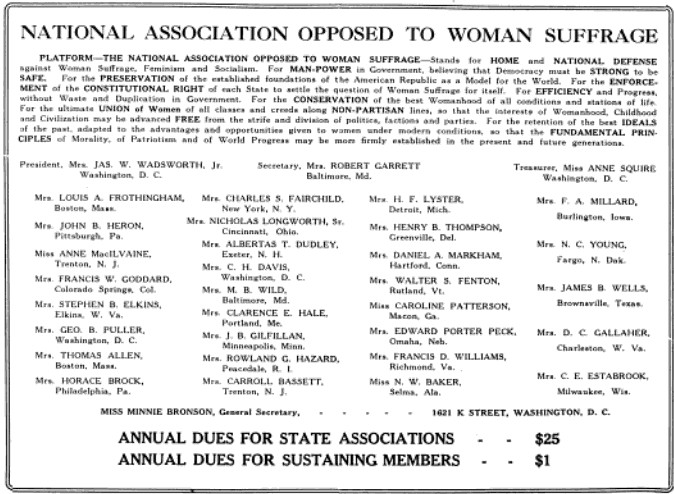
Hallie Davis Elkins, widow of Senator Stephen B. Elkins, was a noted anti-suffragist in West Virginia
.jpg)
Carrie Watson Fleming, former First Lady of West Virginia, was affiliated with the West Virginia Association Opposed to Woman Suffrage
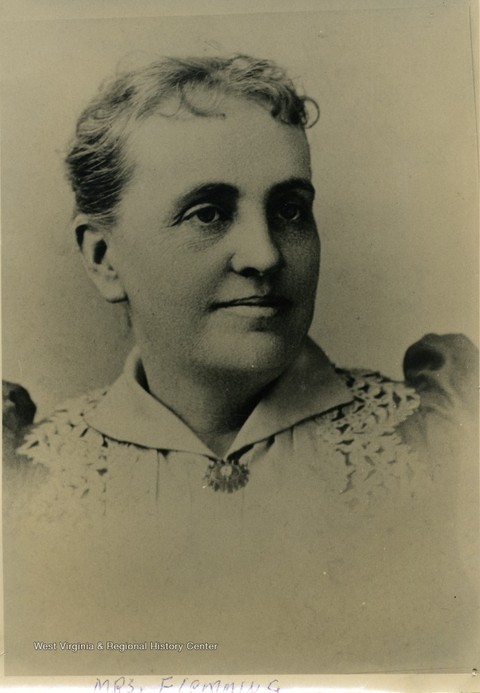
From The Woman Patriot, May 4, 1918.
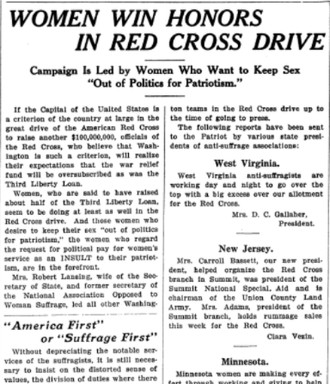
Florence Gallaher is listed on the executive committee for the Fourth Liberty Loan Campaign as representing the "Association Opposed to Woman Suffrage"
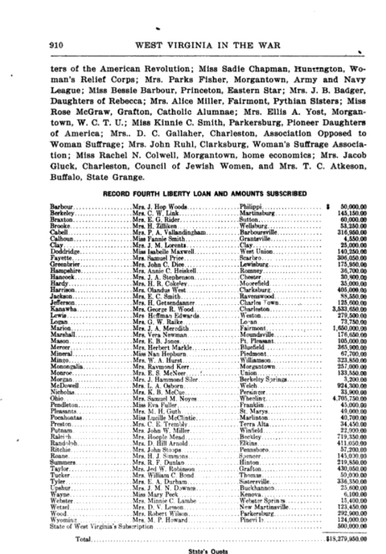
The Remonstrance Against Woman Suffrage, January 1917

Letter from Alice Wadsworth, President of the National Association Opposed to Woman Suffrage, to Senator Howard Sutherland on June 22, 1918. Hallie Davis Elkins (Mrs. Stephen B. Elkins) is listed as a Vice-President and Florence Gallaher (Mrs. D. C. Gallaher) is listed as on the Board of Directors.
.jpg)
Pamphlet distributed by the National Association Opposed to Woman Suffrage, c. 1910
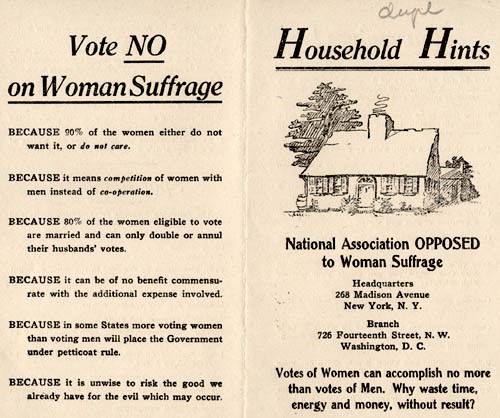
Leaflet issued by the Huntington Association Opposed to Woman Suffrage
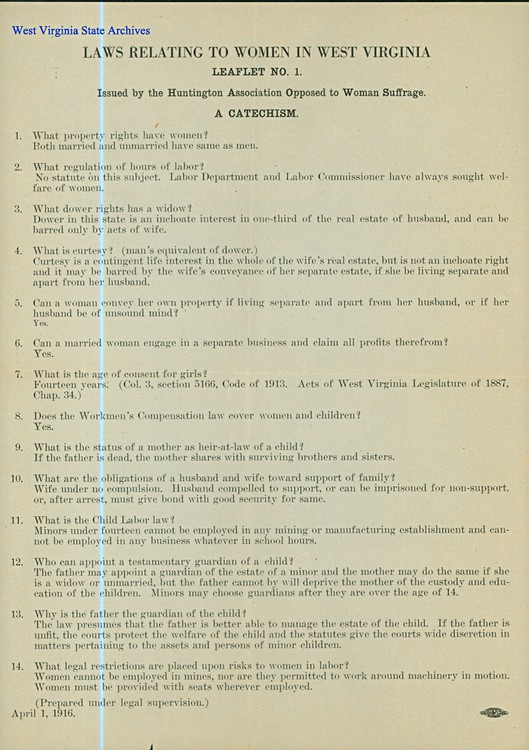
Leaflet issued by the Huntington Association Opposed to Woman Suffrage
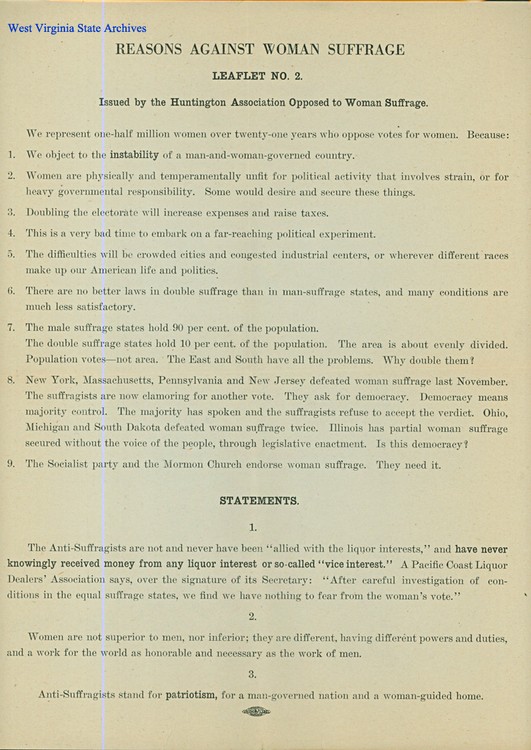
Anti-suffrage advertisement, Huntington Advertiser, November 4, 1916
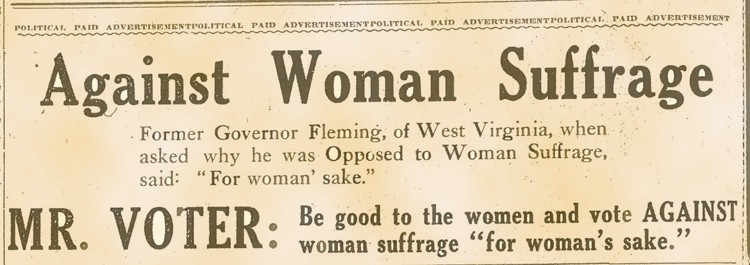
"Some reasons why we oppose votes for women ... National association opposed to woman suffrage. New York City [1894]."
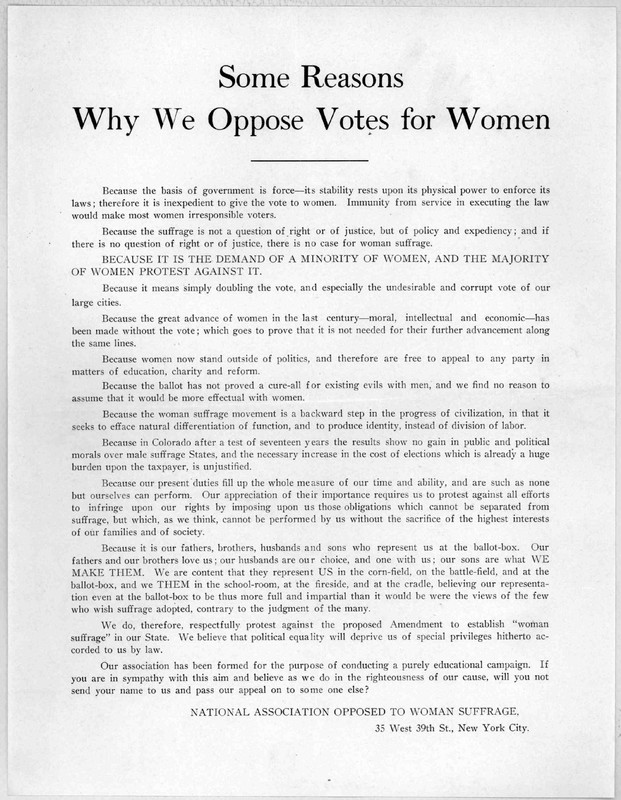
The Sunday Telegram, Clarksburg, WV, October 22, 1916
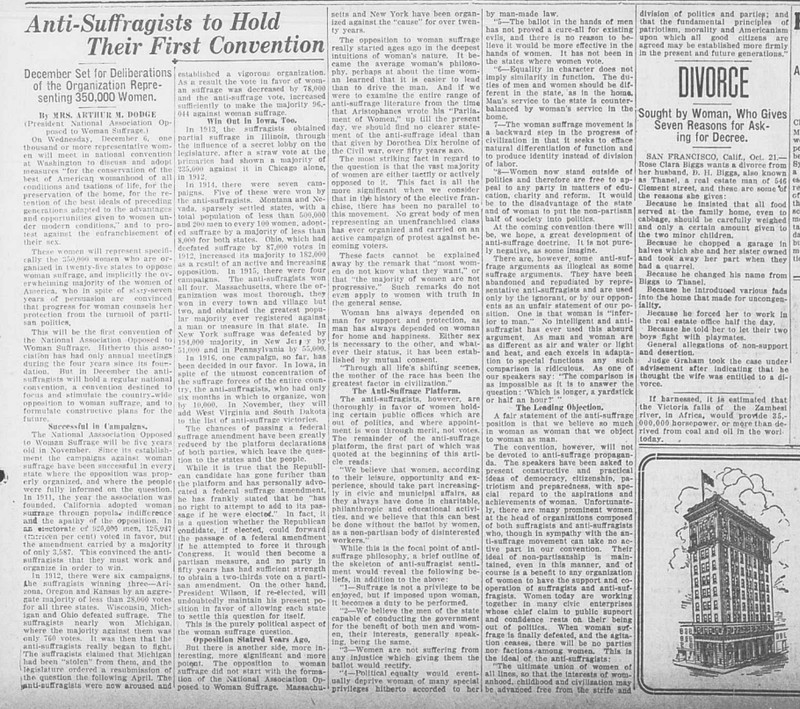
Sanborn Fire Insurance Map from Charleston, Kanawha County, West Virginia, 1912.
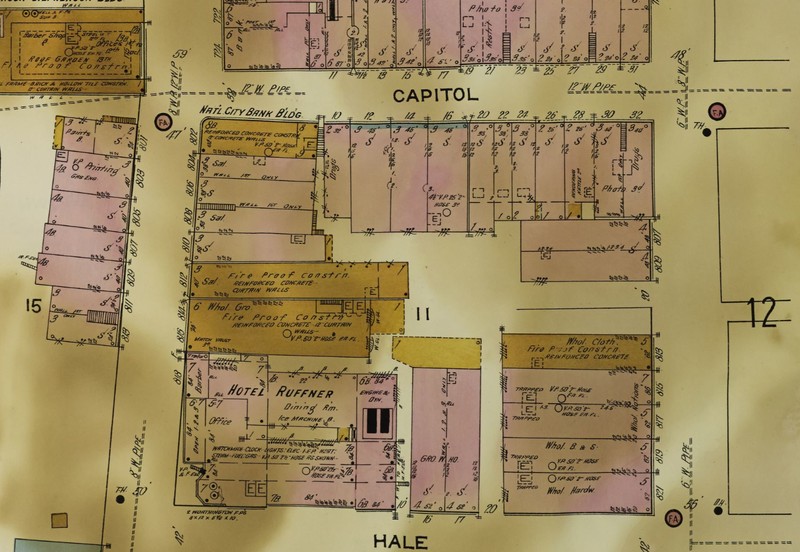
Hotel Ruffner and the 800 block of Kanawha. Postcard, n.d.
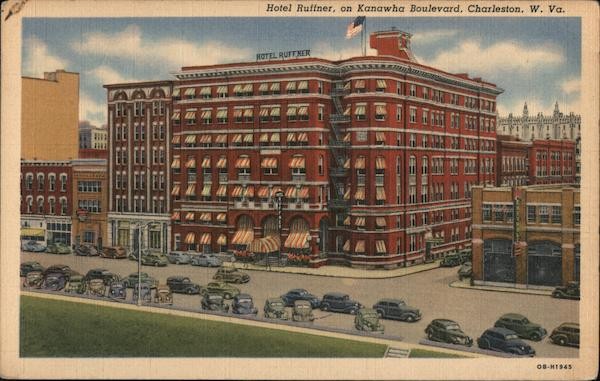
"Aerial view of Business Section of Charleston, W. Va., showing South Side Bridge, Kanawha Blvd. with Riverview Terrace, United Carbon, Ruffner Hotel and Union buildings," c. 1930-1945. The Hotel Ruffner and the 800 block are just to the left of the bridge.
.jpg)
Backstory and Context
Text-to-speech Audio
While the work of pro-suffrage women and supporters had been going on for several decades, the activity of anti-suffrage West Virginian women really emerged during the campaign for the 1916 referendum on women’s suffrage. The West Virginia Association Opposed to Woman Suffrage (WVAOWS) organized in Charleston in June or July 1916. The WVAOWS largely adopted the platform of the National Association Opposed to Woman Suffrage and used the same arguments and tactics.
Nationally, the anti-suffrage movement emerged in the last two decades of the nineteenth-century, in response to the activity and progress of the pro-suffrage movement. Generally, anti-suffrage women were white & born in the United States, Republican, Protestant, and members of the urban, wealthy, social upper class. Many of the arguments from the anti-suffrage side argued that women would lose their already privileged position in society and that granting suffrage to women would be detrimental to women and disastrous to society. Like the pro-suffrage movement, anti-suffragists had a national organization and then state and local level groups associated with the cause.
In addition to the state anti-suffrage organization in Charleston, there were anti-suffrage groups in Wheeling and Huntington. For both the pro- and anti-suffrage sides, West Virginia did not have the strongest or biggest movements (other states were far more active in both sides of the suffrage debates), however the national organizers of both causes were interested in sparking a movement in the state. A large portion of the anti-suffrage advocacy in the state came from outside organizers, especially from the National Association Opposed to Woman Suffrage. One of the main opposition speakers in West Virginia was Claire K. Oliphant (Mrs. O. D. Oliphant) of Trenton, NJ who spoke on several occasions in the state, including both the Democratic and Republican state conventions. In West Virginia the debate over suffrage for women also included competing regional discussions over states’ rights and the temperance movement.
Florence (Florie) Miller Gallaher (Mrs. D. C. Gallaher) served as the president of the West Virginia Association Opposed to Woman Suffrage. She also served on the Board of Directors for the National Association Opposed to Woman Suffrage. Her husband, DeWitt C. Gallaher was a lawyer with offices in the City National Bank Building on the corner. According to the census records, DeWitt and Florence had six children and lived at 1102 Kanawha Street with two servants also listed in their household.
One notable anti-suffrage West Virginian was Hallie Davis Elkins (Mrs. Stephen B. Elkins) who was affiliated with the West Virginia Association Opposed to Woman Suffrage and served as a Vice President in the National Association Opposed to Woman Suffrage. Another prominent woman opposed to suffrage was former First Lady of West Virginia, Carrie Watson Fleming, wife of former governor Aretas B. Fleming. Both Hallie Davis Elkins and Carrie Watson Fleming appear as signatories alongside Florence Miller Gallaher on a memorial from the West Virginia Association Opposed to Woman Suffrage sent to the West Virginia House of Delegates ahead of the 1920 special session considering the ratification of the 19th Amendment.
The address 808 Kanawha is listed as the headquarters of the West Virginia Association Opposed to Woman Suffrage on one of their published broadsides. In the 1910s, this address appears to have been a store front with apartments as in the city directories there are several people living at 808 ½ Kanawha. In 1915 808 Kanawha is listed as the Valley Cigar Store (Lewis C. Summers and Alexander C. Lawrence) and in 1920 it is a wholesale clothing store under Isaac Hirschman. In between, no business is listed at 808 Kanawha in the city directories, which is likely when the WVAOWS used the space.
Sources
“1916 State Referendum.” Fighting the Long Fight: West Virginia Women and the Right to Vote. A West Virginia Archives and History Online Exhibit. Accessed February 7, 2022. https://wvstatemuseumed.wv.gov/chapter-four.html.
“Anti-Suffrage Efforts.” Women’s Suffrage in West Virginia. Accessed February 7, 2022. https://wvsuffrage.lib.wvu.edu/home/s/WV-womens-suffrage/page/anti-suffrage.
Camhi, Jane Jerome. “Women Against Women: American AntiSuffragism, 1880-1920.” Ph.D. Dissertation, Tufts University, 1973.
City Directories, Charleston, WV. Ancestry.com.
Effland, Anne Wallace. “The Woman Suffrage Movement in West Virginia, 1867-1920.” M. A. Thesis, West Virginia University, 1983.
Sanborn Fire Insurance Map from Charleston, Kanawha County, West Virginia. Sanborn Map Company, 1912. Map. https://www.loc.gov/item/sanborn09394_007/. Accessed February 3, 2022.
"The Woman Patriot: A National Newspaper For Home and National Defense Against Woman Suffrage, Feminism and Socialism." April 27, 1918. Accessed February 3, 2022. https://www.google.com/books/edition/The_Woman_Patriot/CmKDP_HRBBwC?hl=en&gbpv=1.
U.S. Census Records. Ancestry.com.
"Mr. Voter!" Vote Against Woman Suffrage. Women's Suffrage in West Virginia. Accessed February 3, 2022. https://wvsuffrage.lib.wvu.edu/home/s/WV-womens-suffrage/item/801.
"Don't Say 'Let Them Vote if They Want To.'" Women's Suffrage in West Virginia. Accessed February 3, 2022. https://wvsuffrage.lib.wvu.edu/home/s/WV-womens-suffrage/item/799.
"We Oppose Woman Suffrage." Women's Suffrage in West Virginia. Accessed February 3, 2022.
"The Woman Patriot: A National Newspaper For Home and National Defense Against Woman Suffrage, Feminism and Socialism." April 27, 1918. Accessed February 3, 2022. https://www.google.com/books/edition/The_Woman_Patriot/CmKDP_HRBBwC?hl=en&gbpv=1.
"Hallie Davis Elkins." Women's Suffrage in West Virginia. Accessed February 7, 2022. https://wvsuffrage.lib.wvu.edu/home/s/WV-womens-suffrage/page/anti-suffrage.
"First Lady of West Virginia, Carrie M. Watson Fleming from Fairmont, W. Va." West Virginia History OnView. West Virginia History & Regional Center. Accessed February 8, 2022. https://wvhistoryonview.org/catalog/038981.
"The Woman Patriot: A National Newspaper for Home and National Defense Against Woman Suffrage, Feminism and Socialism." Vol. 1, No. 2. May 4, 1918. Accessed February 7, 2022. https://www.google.com/books/edition/The_Woman_Patriot/CmKDP_HRBBwC?hl=en&gbpv=1.
Livia Simpson Poffenbarger. "Women in the War." West Virginia in the War. West Virginia Legislative Handbook and Manual and Official Register. 1918. Accessed February 7, 2022. https://books.google.com/books?id=EjY0AQAAMAAJ&printsec=frontcover&source=gbs_ge_summary_r&cad=0#v=onepage&q&f=false.
The Remonstrance Against Woman Suffrage, January 1917. Google Books. Accessed February 7, 2022. https://www.google.com/books/edition/The_Remonstrance/0S5JAQAAMAAJ?hl=en&gbpv=1&bsq=gallaher.
"Letter from Alice Wadsworth (National Association Opposed to Woman Suffrage) to Senator Howard Sutherland." Women's Suffrage in West Virginia. Accessed February 7, 2022. https://wvsuffrage.lib.wvu.edu/home/s/WV-womens-suffrage/item/701.
"National Association Opposed to Woman Suffrage." Wikipedia. Accessed February 7, 2022. https://en.wikipedia.org/wiki/National_Association_Opposed_to_Woman_Suffrage.
"The 1916 State Referendum." Fighting the Long Fight: West Virginia Women and the Right to Vote. A West Virginia Archives and History Online Exhibit. Accessed February 7, 2022. http://129.71.204.160/history////exhibitsonline/suffrage/suffrage4.html.
"The 1916 State Referendum." Fighting the Long Fight: West Virginia Women and the Right to Vote. A West Virginia Archives and History Online Exhibit. Accessed February 7, 2022. http://129.71.204.160/history////exhibitsonline/suffrage/suffrage4.html.
"The 1916 State Referendum." Fighting the Long Fight: West Virginia Women and the Right to Vote. A West Virginia Archives and History Online Exhibit. Accessed February 7, 2022. http://129.71.204.160/history////exhibitsonline/suffrage/suffrage4.html.
National Association Opposed To Woman Suffrage. Some reasons why we oppose votes for women ... National association opposed to woman suffrage. New York City. New York, 1894. Pdf. https://www.loc.gov/item/rbpe.1300130c/. Accessed February 8, 2022.
The Sunday telegram. [volume], October 22, 1916, Page PAGE NINE, Image 9. Chronicling America. Accessed February 7, 2022. https://chroniclingamerica.loc.gov/lccn/sn85059732/1916-10-22/ed-1/seq-9/#date1=1915&index=0&rows=20&words=Anti+anti+Anti-Suffrage+anti-suffrage+Suffrage+suffrage&searchType=basic&sequence=0&state=West+Virginia&date2=1917&proxtext=anti+suffrage&y=0&x=0&dateFilterType=yearRange&page=1.
Sanborn Fire Insurance Map from Charleston, Kanawha County, West Virginia. Sanborn Map Company, 1912. Map. https://www.loc.gov/item/sanborn09394_007/. Accessed February 3, 2022.
"Hotel Ruffner, on Kanawha Boulevard, Charleston, W. Va." CardCow. Accessed February 8, 2022. https://www.cardcow.com/834418/charleston-west-virginia-hotel-ruffner-kanawha-boulevard/.
"Aerial view of Business Section of Charleston, W. Va., showing South Side Bridge, Kanawha Blvd. with Riverview Terrace, United Carbon, Ruffner Hotel and Union buildings."
